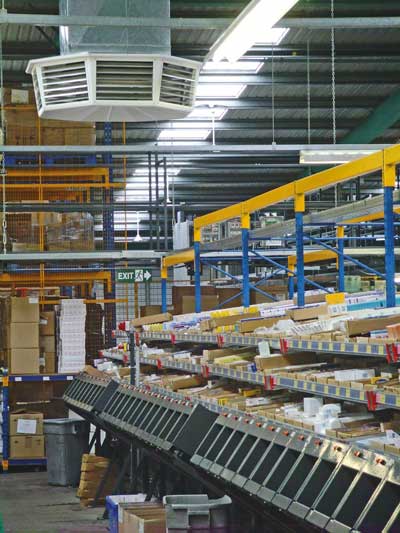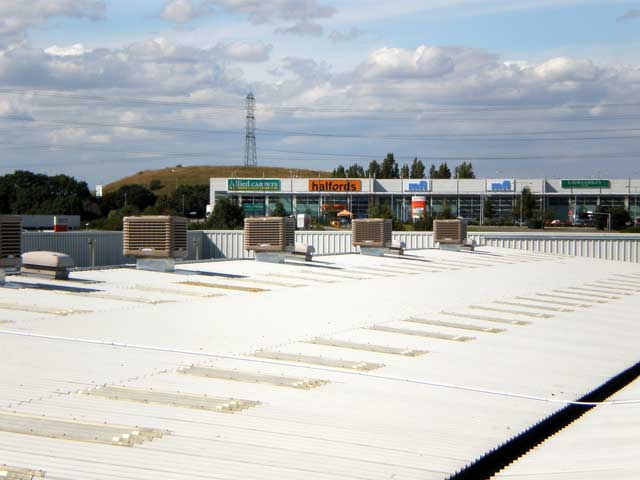
Evaporative cooling can keep warehouses and factories at a comfortable temperature for a fraction of the cost of traditional air conditioning. Emma Beresford, head of sales and marketing at EcoCooling explains.
Evaporative or adiabatic cooling is a natural, cost-effective and environmentally friendly alternative to traditional air conditioning.
Industrial evaporative air coolers build on the natural process of evaporative cooling by incorporating it into ventilation systems to cool incoming air. Fans draw ambient outdoor air through saturated cooler pads to produce the evaporative cooling effect. The fresh, cool air is then delivered into the building interior. As warm air rises, it is removed through an extractor fan on the roof.
Evaporative cooling is becoming a popular alternative to traditional refrigeration air conditioning for many reasons, the main one being that is highly cost-effective.
Warehouses are prone to overheating in summer, particularly those where mezzanine floors have been built, or new warehouses that are well insulated. Evaporative cooling can offer a balanced ventilation scheme which can guarantee supply air temperatures below 25°C all year round in the UK, and can operate at just 10% of the cost of traditional air conditioning. The capital cost of an evaporative cooling system is typically only 60% of that of a traditional air conditioning system.
Evaporative cooling also needs no refrigerants.
For buildings with a large floor area such as warehouses and factories, the savings can be significant.
Evaporative coolers are used as part of a mechanical ventilation system. As ambient external air is drawn into the ventilation system, it travels through filter pads saturated with water. The water evaporates as the air passes through, and as it does so, energy is lost from the air, reducing its temperature. Control systems automatically match the airflow to the amount of cooling required. An extract fan is specified to match the supply fan.
Smart control
A number of recent developments in control systems have made possible broader applications for this technology. Originally, the advanced control system was only used in IT applications such as cooling of general data centres, telecommunication exchanges, and UPS rooms, but new hardware has allowed the development of a cost-effective version which is now available for industrial and warehouse cooling.
Benefits include closer control of temperature and energy monitoring; remote access; real-time analysis of temperature and humidity from smart devices; a touchscreen interface. The system can be used for combined ventilation, cooling and heating projects and easily connected to Modbus and Ethernet (for building management and fire suppressant systems and the like).
Such a system can be used to closely control the temperature of air going into a warehouse or factory.
Another advantage is built-in destratification. In colder weather, hot air will rise to the warehouse roof. This can be redirected to lower levels using the evaporative cooling supply fan (in non-cooling mode), reducing the heating requirement of the building.
The system can be integrated with building management systems for energy monitoring and fault recording, which allows for better monitoring of the performance of the systems.
CASE STUDY
 A leading retailer was experiencing temperatures of more than 40°C during summer in its UK distribution centres, with staff describing the working conditions as unbearable. There was no choice but to look for a cooling solution for the building.
A leading retailer was experiencing temperatures of more than 40°C during summer in its UK distribution centres, with staff describing the working conditions as unbearable. There was no choice but to look for a cooling solution for the building.
The cost of conventional air conditioning for the whole centre would have been unrealistic. EcoCooling’s evaporative cooling and air handling solutions provided the cooling required to maintain bearable temperatures with a cost-effective installation and at a sensible operating cost.
An EcoCooling system provided fresh-air spot-cooling to the hottest areas, while also gently cooling the rest of the centre. The new system has made staff more comfortable, is costing the company less in water and break time and has received a promising response from the health and safety committee. Following the success of the initial installation, this retailer has commissioned an additional four sites with EcoCooling systems.

